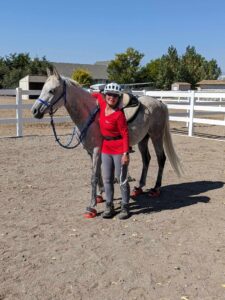 I just recently had my first ride on Saint Croix and wanted to share a little bit about the process that I went through.
I just recently had my first ride on Saint Croix and wanted to share a little bit about the process that I went through.
I wanted to make sure that we both felt comfortable and relaxed and have it be a good experience. When I first got Saint he earned the nickname Chili Pepper, because it was a little bit spicy. He wouldn’t let me catch him for the first couple of days and just generally needed some time to get comfortable in his new surroundings. Saint was a little bit anxious and nervous and would paw, pace the fence, toss his head and was emotional. Yet he was also super friendly and curious so it didn’t take long until he settled in.
I decided that it would be better if I let Saint have a little bit of time before I asked anything of him. It wasn’t long until I was able to halter him, or put a fly mask on. I slowly started asking for more like picking up a foot or grooming him.
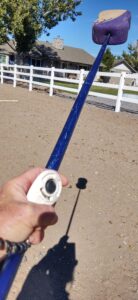
This is when I started doing some refresher learning myself about R+ (Positive Reinforcement) training. I listened to several more podcasts and watched some YouTube videos on the topic. Back in 2021 I had used R+ with Jovi and it helped tremendously.
I spent a couple more weeks doing the basics – rope work, leading, tying, picking up feet and doing some liberty work getting Saint to follow me through an obstacle course. He eagerly participated and learned quickly and at this point I was offering positive reinforcement in the form of pats and praise with an occasional small piece of carrot.
 Then I started using the clicker and started adding more voice cues to Saint’s repertoire. I put my driving curcingle on him with two lines for reins and a bridle with a snaffle and started ground driving. At this point he had already shown that he was fine about ropes all over his body and legs, or being dragged on either or both sides of him. Now we were progressing to actually driving him with me behind him. He quickly learned ‘walk’, and ‘whoa’. When he did what I wanted, I would click, then drop the reins and walk up to his head and reward him with some timothy pellets or a small piece of carrot.
Then I started using the clicker and started adding more voice cues to Saint’s repertoire. I put my driving curcingle on him with two lines for reins and a bridle with a snaffle and started ground driving. At this point he had already shown that he was fine about ropes all over his body and legs, or being dragged on either or both sides of him. Now we were progressing to actually driving him with me behind him. He quickly learned ‘walk’, and ‘whoa’. When he did what I wanted, I would click, then drop the reins and walk up to his head and reward him with some timothy pellets or a small piece of carrot.
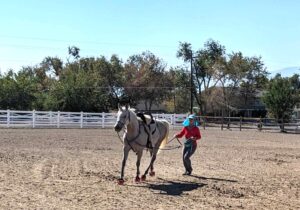 At first I kept the lessons fairly short always ending on a good note. In a handful of lessons Saint was ground driving through and over obstacles and all over the property. He could walk, trot, stop, turn and back with precision. This is when I decided it was time to get on him for the first time.
At first I kept the lessons fairly short always ending on a good note. In a handful of lessons Saint was ground driving through and over obstacles and all over the property. He could walk, trot, stop, turn and back with precision. This is when I decided it was time to get on him for the first time.

In between the ground driving lessons I was also working on R+ target training. I used a large sponge on the end of a ski pole.
By the second click followed by some timothy pellets Saint had it figured out. He now would go anywhere I placed the target (the sponge on the pole) and touch it when I said “tap”, and hold his nose to it for a few seconds. Followed by a reward of pellets held away from my body, so he was also learning to “stay out of my space”. Now he knows that term when I use it while waving my arms close to my body. He won’t get his reward if he isn’t respectful of my space or gets pushy, or lippy. So far he has been super delicate and polite about the treat rewards.
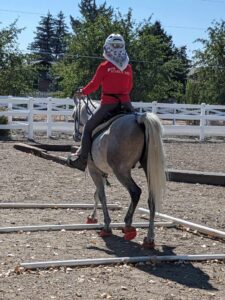 This is where the power of both latent and observational learning was so obvious with Saint. I wasn’t doing the same traininng lessons, or any some days at all because I was working with another horse while Saint observed.
This is where the power of both latent and observational learning was so obvious with Saint. I wasn’t doing the same traininng lessons, or any some days at all because I was working with another horse while Saint observed.
Latent learning is the theory that horses learn after having a few days to process a lesson. This is why doing a ground driving lessons every two or three days really showed how well Saint was improving and how he was figuring it out mentally. I can give more examples of this in future posts as it is a fascinating topic.
One of the R+ target training I did with Saint to get him ready for having a rider mount was relatively easy. I simply had him follow the target to line up next to various objects that I could stand on – an upside down half barrel, a mounting block, a railroad tie. Then I leaned over his back while holding the target out to one side or the other and asked him to “tap”, then clicked and rewarded. This way he got comfortable with me leaning over his back but also understood that he was also going to get rewarded by turning his head around and taking it from my hand in the same position it would be in once I was mounted.
 Over the course of ground driving we went from using the driving curcingle to fully tacking Saint up. R+ training worked well for that as well and he readily accepted all of his tack including a crupper, breast collar and hoof boots.
Over the course of ground driving we went from using the driving curcingle to fully tacking Saint up. R+ training worked well for that as well and he readily accepted all of his tack including a crupper, breast collar and hoof boots.
Saint lined himself up perfectly to my mounting block using the target. He will follow the target and go anywhere I direct him now. That makes mounting easy and eventually we’ll be doing it reliablly without needing the target. Now I stood up in the stirrup on one side, gave him a treat while leaning over his back. He was so calm and relaxed that I just threw my leg over the saddle and then praised him and gave him another reward. We both felt safe. All the weeks of groundwork had melted away Saint’s anxiousness.
 I had my husband lead us around for a minute then I dismounted and went up to the front arena where I mounted back up again. I followed the same process with positive rewarding Saint’s good behavior.
I had my husband lead us around for a minute then I dismounted and went up to the front arena where I mounted back up again. I followed the same process with positive rewarding Saint’s good behavior.
Now we simply did a short lesson going through and over some of the obstacles. We walked, trotted, turned, stopped and backed a couple of steps. Ended on a good note and then led back to the barn to untack.
Rather than go into a huge amount of detail on R+ I’m going to add a couple of links below for those interested in listening to podcasts or watching videos on the topic.
R+ is a proven method for training horses and can be done relatively inexpensively. I used items that I already had to make a target and have been using timothy hay pellets that I keep in an old fanny pack, plus a clicker that I had. A voice click will also work.
These links will get anybody started learning about Positive Reinforcement training. There are lots more resources including groups on FB for those that would like to learn more. It is all in the timing. In some cases I felt that listening to a podcast to be more helpful and other times watching a video. Kind of like my horses, I also learn using different methods, or a combination of them.
Equine Clicker Training 101, Shawna Karrasch podcast
How to Start Clicker Training with Positive Reinforcement video

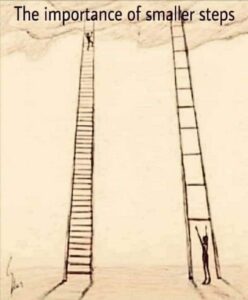 VG Midnight Cowboy and Saint Croix both arrived here a month ago. Since then I’ve been working with them on a lot of basic groundwork while giving them the space and time to settle in to their new home.
VG Midnight Cowboy and Saint Croix both arrived here a month ago. Since then I’ve been working with them on a lot of basic groundwork while giving them the space and time to settle in to their new home.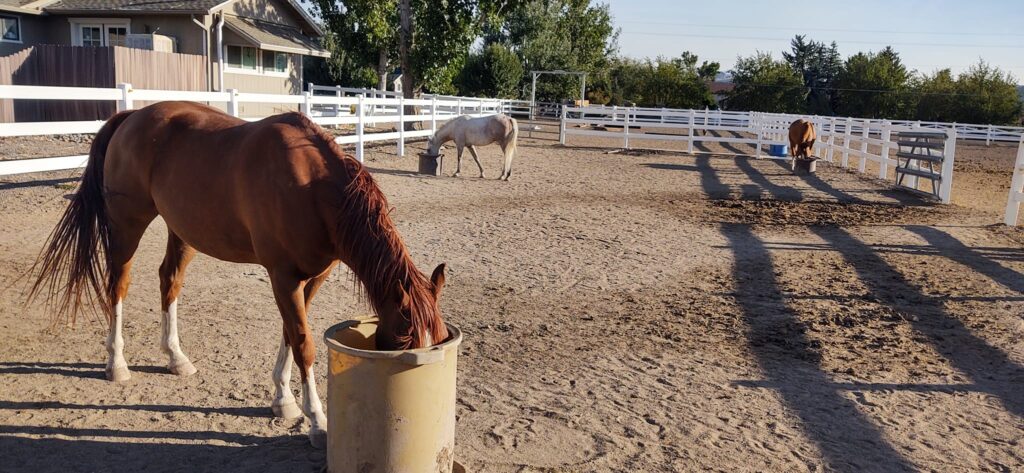 I learned to separate Jovi for some feedings while making sure that plenty of hay was spread around in a way so that the two new horses wouldn’t get cornered. I have since picked up a 3rd
I learned to separate Jovi for some feedings while making sure that plenty of hay was spread around in a way so that the two new horses wouldn’t get cornered. I have since picked up a 3rd  I’ve been getting Saint and Cowboy used to eating wet mashes made from
I’ve been getting Saint and Cowboy used to eating wet mashes made from  1. Fly Masks: Saint and Cowboy are now comfortable with putting fly masks on and off. They weren’t sure about the velcro sound at first but now are totally fine with it.
1. Fly Masks: Saint and Cowboy are now comfortable with putting fly masks on and off. They weren’t sure about the velcro sound at first but now are totally fine with it.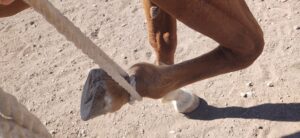
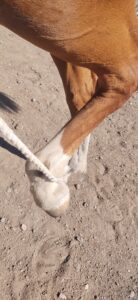 4. Cotton Rope: Both were easy to work with on the ground using a cotton rope. I have put the rope around their bodies and used it to pick up each leg forward and back. I also have allowed each horse to drag a shorter rope. No panicking or stress, just calm horses enjoying getting attention. Each horse watches the other one get worked and then tries to show off when it is their turn. I’ve been really impressed with how fast they pick stuff up.
4. Cotton Rope: Both were easy to work with on the ground using a cotton rope. I have put the rope around their bodies and used it to pick up each leg forward and back. I also have allowed each horse to drag a shorter rope. No panicking or stress, just calm horses enjoying getting attention. Each horse watches the other one get worked and then tries to show off when it is their turn. I’ve been really impressed with how fast they pick stuff up. 5. Longing: We started with just simply walking in a circle and progressed up to now the horses both longe each direction on a line and at liberty. It will take more time for them to be proficient with all of the voice cues. I prefer to work them at liberty in a larger area over using a line and doing small circles.
5. Longing: We started with just simply walking in a circle and progressed up to now the horses both longe each direction on a line and at liberty. It will take more time for them to be proficient with all of the voice cues. I prefer to work them at liberty in a larger area over using a line and doing small circles.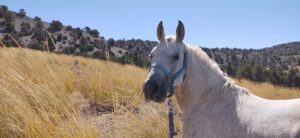 7. Tied to the trailer: Each horse has taken turns together or with Jovi being tied on the trailer. I have the Trailer Ties out with hay bags and water buckets on the trailer. This is when I spend time grooming them, picking up feet and letting them just hang out, eat and watch all of the goings on.
7. Tied to the trailer: Each horse has taken turns together or with Jovi being tied on the trailer. I have the Trailer Ties out with hay bags and water buckets on the trailer. This is when I spend time grooming them, picking up feet and letting them just hang out, eat and watch all of the goings on.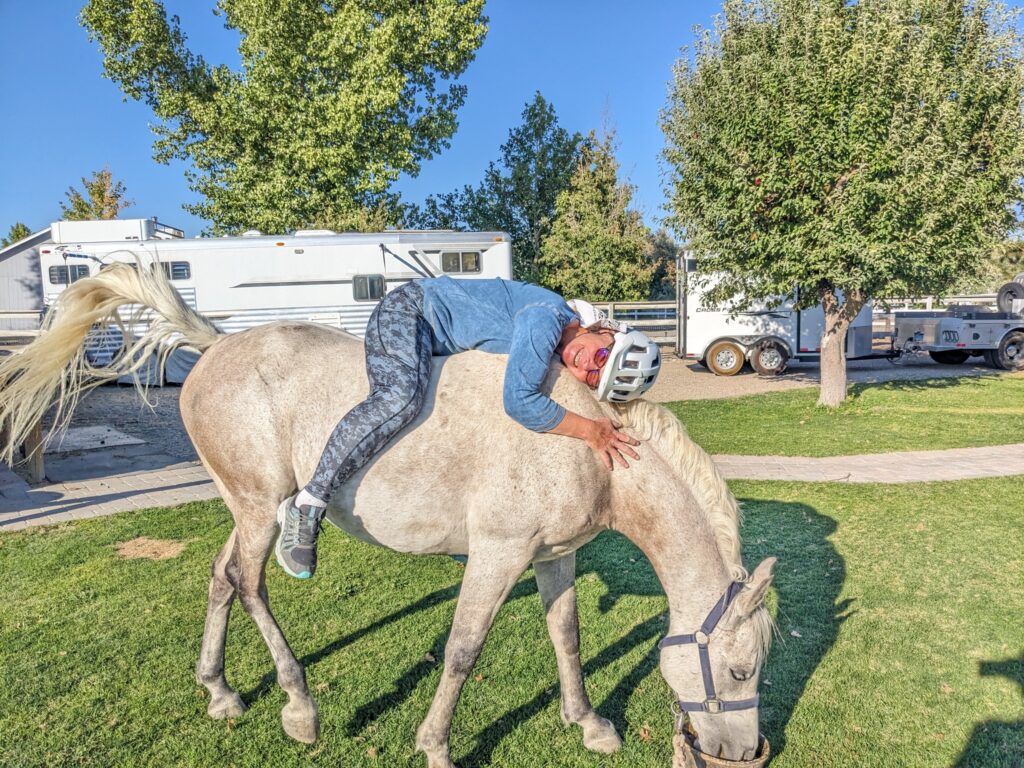 So I’d say that we have made a lot of progress already. I am taking it slow and careful with the new horses. I realize that mentally they both need time to get settled and comfortable in their new home. It is different for each horse though I feel that usually it takes about six months.
So I’d say that we have made a lot of progress already. I am taking it slow and careful with the new horses. I realize that mentally they both need time to get settled and comfortable in their new home. It is different for each horse though I feel that usually it takes about six months. Things have been going well with both Saint Croix and Midnight Cowboy. They are adjusting into their new home and getting more comfortable and familiar with the routine and their surroundings.Jovi has been a bit jealous about me spending time with another horse. In the last week I have taken him to a night ride, and also did some more Ride and Tie training for the upcoming R&T than I plan to take him to at the end of the month.
Things have been going well with both Saint Croix and Midnight Cowboy. They are adjusting into their new home and getting more comfortable and familiar with the routine and their surroundings.Jovi has been a bit jealous about me spending time with another horse. In the last week I have taken him to a night ride, and also did some more Ride and Tie training for the upcoming R&T than I plan to take him to at the end of the month.
 So for the first week and a half these are some of the things that we have accomplished:
So for the first week and a half these are some of the things that we have accomplished: Leading through gates and stalls (initially they weren’t sure about some of the new things)
Leading through gates and stalls (initially they weren’t sure about some of the new things) Fly spray. Saint Croix is accepting a bit faster though Cowboy has made great progress. Something we’ll just keep working on a little at a time. They say Pigeon Fever is going around so it is important that I keep everything sprayed.
Fly spray. Saint Croix is accepting a bit faster though Cowboy has made great progress. Something we’ll just keep working on a little at a time. They say Pigeon Fever is going around so it is important that I keep everything sprayed. I’ve also measured them with a weight tape for height, girth circumfrance, cannon bones, etc. Saint Croix turned 8 in June and is 13.2, 7.25″ cannon bone and 4.6″ wide front hooves. VG Midnight Cowboy turned 4 in June and is just over 14 hands, 8″ cannon bone and 5″ wide feet. VG Ben Jovi is fully mature now at 9 and 14.2, 8″ cannon bone and over 5″ wide feet. The weight tape gives an estimate on their weight and puts the two new ones at 750-800 pounds which seems about right.
I’ve also measured them with a weight tape for height, girth circumfrance, cannon bones, etc. Saint Croix turned 8 in June and is 13.2, 7.25″ cannon bone and 4.6″ wide front hooves. VG Midnight Cowboy turned 4 in June and is just over 14 hands, 8″ cannon bone and 5″ wide feet. VG Ben Jovi is fully mature now at 9 and 14.2, 8″ cannon bone and over 5″ wide feet. The weight tape gives an estimate on their weight and puts the two new ones at 750-800 pounds which seems about right. This is my new horse VG Midnight Cowboy. He just turned 4 in June 2023 and is from Van Gilder Arabians. I’m fortunate enough now to have two “VG” horses. Cowboy has three white socks while Jovi has four so even my husband can tell them apart!
This is my new horse VG Midnight Cowboy. He just turned 4 in June 2023 and is from Van Gilder Arabians. I’m fortunate enough now to have two “VG” horses. Cowboy has three white socks while Jovi has four so even my husband can tell them apart! I’m really impressed with how calm and laid back this horse is. So far he has been taking everything in stride and staying totally cool and collected. He has been watching the llams with curiosity though they are timid and still haven’t come over to the fenceline. He is quite the foodie, and has a lovely floating trot.
I’m really impressed with how calm and laid back this horse is. So far he has been taking everything in stride and staying totally cool and collected. He has been watching the llams with curiosity though they are timid and still haven’t come over to the fenceline. He is quite the foodie, and has a lovely floating trot.
